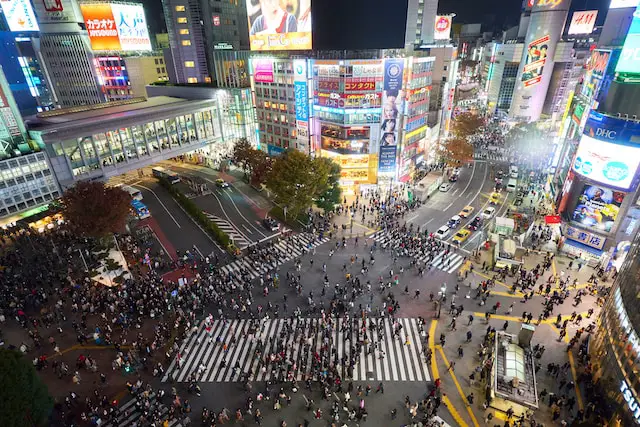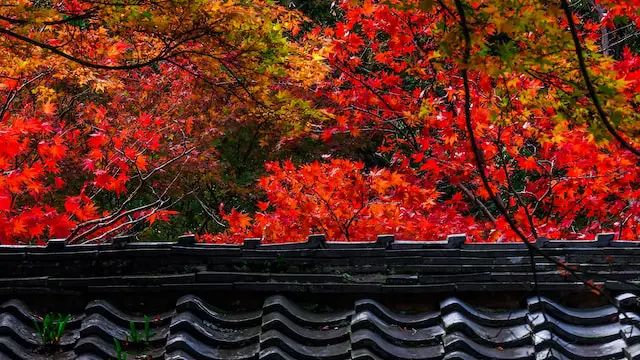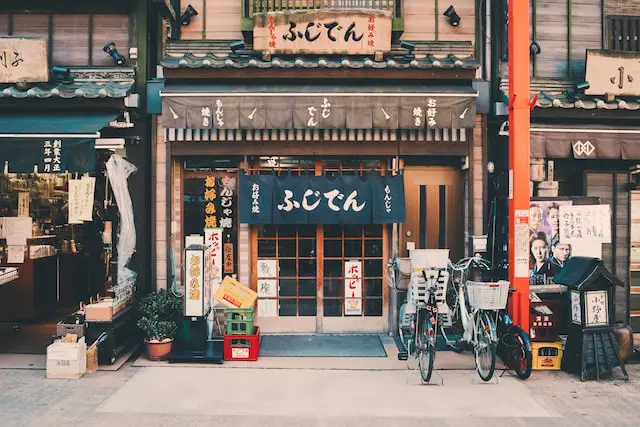Magnificent structures crafted from snow and dazzling displays of sparkling lights – this is winter in Japan! Japan transforms into an enchanting wonderland bathed in wintry magic unlike anywhere else. Lit up in vibrant hues that only winter illuminations in Japan can offer, the streets and parks come alive with surreal beauty.
Yet, the winter enchantment doesn’t stop at illuminations. The country also hosts fascinating snow festivals, Japan’s winter invitation to embrace the cold. The sight of intricate snow sculptures representing Japanese cultural festivities attracts countless admirers to these events annually.
In this feature, we delve into these Japanese winter wonders, focusing on catching the awe-inspiring snow festivals and mystifying winter illuminations. Join us as we journey through the snow-cloaked, vibrant Japanese destinations rich in tradition and splendor.
The Cultural Significance of Snow Festivals in Japan
There’s nothing quite like the sheer charm of Japan’s snow festivals. Deep-rooted in Japanese history, these festivals bring forth a delightful fusion of modernity and traditional values in the most heartwarming manner.
Enthralling Japanese cultural festivities transform the stark winter landscapes into artistic masterpieces. These intricate transformations are best exemplified during the grand snow sculpting event, which stems from the revered practice of crafting Japanese traditional snow sculptures dating back hundreds of years. Interestingly, these sculptures often depict renowned cultural entities, captivating folklore, or honoring legendary Japanese figures, thereby encapsulating the depth and diversity of Japan’s rich heritage.
The snow festival phenomenon became an integral component of winter tradition in Japan, drawing millions of locals and global tourists. These snow-covered fiestas offer everything from live performances to local delicacies to prestigious snow art competitions.
The onset of winter in Japan engenders a spirit of communal participation, turning frozen conurbations into a hub of creativity and camaraderie. In essence, the jubilation around snow festivals helps transcend the harshness of winter, promoting communal resilience and unique celebration, thereby weaving a sociocultural tapestry that’s distinctively Japanese.
The snow festivals offer more than just visual spectacles; they reaffirm Japan’s ties with nature, pay homage to its cultural norms, and exemplify a spirit of unity and perseverance familiar to Japanese community life.
Discovering Sapporo Snow Festival: Yuki Matsuri
Imagine a city transformed into an enchanted winter wonderland with intricate ice sculptures and snow carvings. This is not a scene from a movie but the reality during the Sapporo Snow Festival or Yuki Matsuri.
Every year in February, Hokkaido’s capital city, Sapporo, plays host to one of Japan’s most enthralling winter events. Initially started by local high school students in 1950, the Yuki Matsuri has grown in stature and popularity, drawing more than 2 million visitors from around the globe.
The highlight of this winter event is undeniably the breathtaking snow sculptures. Ranging from replicas of iconic world monuments to fantastical creatures, each sculpture is a testament to Japan’s cultural virtuosity and the boundless creativity of the human spirit.
I was wondering what to do in Sapporo during this winter fest. The city comes alive with food stalls serving local delicacies, captivating concerts, and theatrical performances, all set against the picturesque backdrop of twinkling lights and snow. There’s also a skiing and snowboarding station for those seeking a bit of adrenaline.
The festival spans three main sites: Odori Park, Tsudome, and Susukino. At the Odori site, the monumental snow sculptures dominate the scene. Susukino is renowned for its radiant ice sculpture creativity, and the Tsudome site is a paradise for families with snow slides and rafting.
Whether you’re a lover of art, food, or culture or simply a snow enthusiast, the Sapporo Snow Festival is bound to be an experience of a lifetime. So, next time you plan a winter vacation, don’t forget to add Sapporo!
A Journey through Otaru Snow Light Path Festival
Once winter sets in, the charming seaside city of Otaru, famous for its historic canal and beautiful glassworks, dons a magical appearance that enchants travelers. The Otaru Snow Light Path festival is central to this wintry spectacle, a gentle symphony of snow and light that paints Otaru in ethereal beauty.
The festival in February every year transforms the city into a mesmerizing fairytale land as thousands of glowing lanterns and miniature snow sculptures line the streets, canals, and even private homes. The spectacle alongside the Otaru Canal, where floating candles set the icy water aglow, is incredibly captivating.
The Snow Light Path Festival is a must-see for those planning winter travel in Otaru. The festival showcases the city’s snowy landscapes and preserves and promotes the community spirit among locals who come together to create this enchanting sight.
Traveling to Otaru during the festival also presents an opportunity to witness ‘Japan’s lantern festival,’ an event unique to Otaru. It’s a time when the city reverberates with a sense of tranquility and warmth despite the harsh winter chill.
While the festival is undoubtedly the highlight of the winter travel in Otaru, the city offers plenty of other activities – from exploring historic attractions like the Otaru Canal and Shioya Hill to savoring delicious seafood and shopping for unique glass art pieces. So why wait? Bask in the soft glow of the Otaru Snow Light Path Festival and experience winter in Japan like never before.</p
The Experience of Nozawa Onsen Fire Festival
Blanketed in shimmering snow, Nozawa Onsen transforms into an enchanting wonderland each winter. Here, the most awaited event is the Nozawa Onsen Fire Festival. This festival is a feast for your senses with its breathtaking visuals and exhilarating sounds, but it also offers profound insights into traditional Japanese fire ceremonies.
Seeped in centuries-old tradition, this ritualistic event captivates locals and travelers with its passionate representation of unity, spiritual purity, and endurance. Held on January 15th every year, the festival brings the town to life as they build a giant wooden structure called a ‘Shaden,’ only to set it aflame in a thrilling display of fireworks and fervor. This spectacle symbolizes an antiquated purge of evil spirits and prayers for the well-being of all children.
The ceremonial aspect is accompanied by fun-filled ‘snowball fights.’ Adults and children alike revel in the snowy playground that Nozawa Onsen becomes. With white landscapes as far as the eye can see, attendees can also partake in various other snow activities besides the Nozawa Fire Festival.
Immersing yourself in local traditions, heart-warming community spirit, and picturesque snowscapes, a visit to the Nozawa Onsen Fire Festival promises to make your winter in Japan unforgettable.
To experience winter traditions in Japan in their purest form, this is a snow festival in Nozawa that you cannot afford to miss.
The Magic of Winter Illuminations in Japan
In the heart of Japan’s ethereal winter setting lies an enchanting tradition – the captivating spectacle of “Japan’s Winter Illuminations.” A holiday staple and unmissable sight, the Illuminations are a thriving part of winter festivities across the country, bathing entire cities in a remarkable glow that imprints unforgettable memories.
These mesmerizing displays, also known as “Japanese light-up festivals,” are not merely about brightening the dark winter nights. They are deeply interwoven with Japanese tradition, holding profound emotional significance for locals and visitors alike. From quaint countryside towns to bustling urban cityscapes, illuminations transform familiar scenes into entrancing wonderlands, wrapping everything in a magical veil of colored light.
From November through February, these light showcases become sprawling canvases of artistic expression. Thousands of LED lights are sculpted into spellbinding designs, from elegant flower gardens to cosmic wonderlands, offering an immersive experience to all who venture there.
Moreover, “Illuminations in Japan” also become hubs for communal gatherings. Families and friends come together to feast their eyes on the vibrant displays, warm their hands with cups of hot amazake, and fill the air with hearty laughter and chatter.
The allure of Japan’s winter illuminations goes well beyond the visual spectacle. They symbolize the spirit of togetherness, hope, and joy that threads through the fabric of Japanese society during the winter months, making them an integral part of the Land of the Rising Sun holiday season.
Showcase of Main Winter Illuminations: Nabana no Sato, Kobe Luminaire, and Winter Illumination in Tokyo
Regarding dazzling displays that light up the winter nights, Japan stands unparalleled. Amongst the many, three winter illumination events outshine the rest and warrant special attention: Nabana no Sato, Kobe Luminaire, and the Winter Illumination in Tokyo.
Let’s start with Nabana no Sato, in Mie prefecture. This is one of the ‘Best illuminations in Japan.’ It is a vast botanical garden transformed into a mesmerizing wonderland of lights. The highlight is its famous light tunnel, something straight out of a fairytale!
Moving towards the urban cityscape, we encounter Kobe Luminaire. This enchanting light-up festival has deep roots in the city’s history and was created to commemorate the victims of the Great Hanshin earthquake. With magnificent hand-painted lights donated from Italy, it’s more than just a spectacle; it symbolizes resilience and hope.
Finally, there’s the Winter Illumination in Tokyo. The city becomes awash with millions of shining lights as multiple districts compete to have the most dazzling displays. Particularly noteworthy is the Caretta Shiodome, with its annual themed illumination show.
Experiencing these illumination events is like stepping into a luminous dream. The Japanese have perfected the craft of light display, making winter in Japan a season of wonder, vibrant brightness, and enchanting evenings.
Conclusion
Your grasp of Japan’s winter wonders and festivities should now leave you inspired and intrigued. Ceremonial snow sculptures and entrancing illuminations encapsulate a magical journey into “Winter in Japan.”
The Sapporo Snow Festival (Yuki Matsuri) and the Otaru Snow Light Path seal Hokkaido as essential spots for your “Winter travel in Japan.” Immersing in the culturally rich Nozawa Onsen Fire Festival offers a unique blend of traditional Japanese fire ceremonies and enjoyable snowy escapades.
Don’t overlook the captivating allure of Japan’s Winter Illuminations, with places like Nabana no Sato, Kobe Luminaire, and numerous Light-up festivals in Tokyo painting the winter nights with awe-inspiring hues and patterns.
Travel tips to remember include layering up to stay warm, abiding by local customs, and keeping an open mind to experience the variances in “Japanese winter tradition.”
Conclusion
In conclusion, Japan’s beautiful winter landscape brims with festive charm, making it an ideal destination for travel enthusiasts, adventure seekers, and those looking for a serene winter retreat. You can immerse yourself in the rhythmic flurry of snowfall adorning enchanting light displays, participate in lively festivals, or indulge in seasonal dishes by the fire. The phrase “Winter Festival travel tips” hardly captures the profound experience that forms the quintessential “Japanese winter experience.”
Whether through the majesty of snow festivals or the ethereal beauty of illuminations, winter in Japan has something for everyone. So, pack your winter gear and embrace winter’s unique, heartwarming wonders. Remember, your journey is as important as the destination, so make every moment count on your next visit to Japan in winter!



